
Dreaming of a White Christmas
It’s common for Bay Area cruisers to talk about the day they head out the Gate and ‘take a left.’ Occasionally, some cruisers will take the road less traveled and go right. Chad and Carolyn Carvey, formerly living aboard in Sausalito on their De Villiers 43 steel cutter Walk On, were featured in our December Changes in Latitudes about the past summer’s cruising in the Pacific Northwest. Now the summer is over, yet they still can’t seem to get enough of the North. They’re staying on for the white Christmas, which comes early.
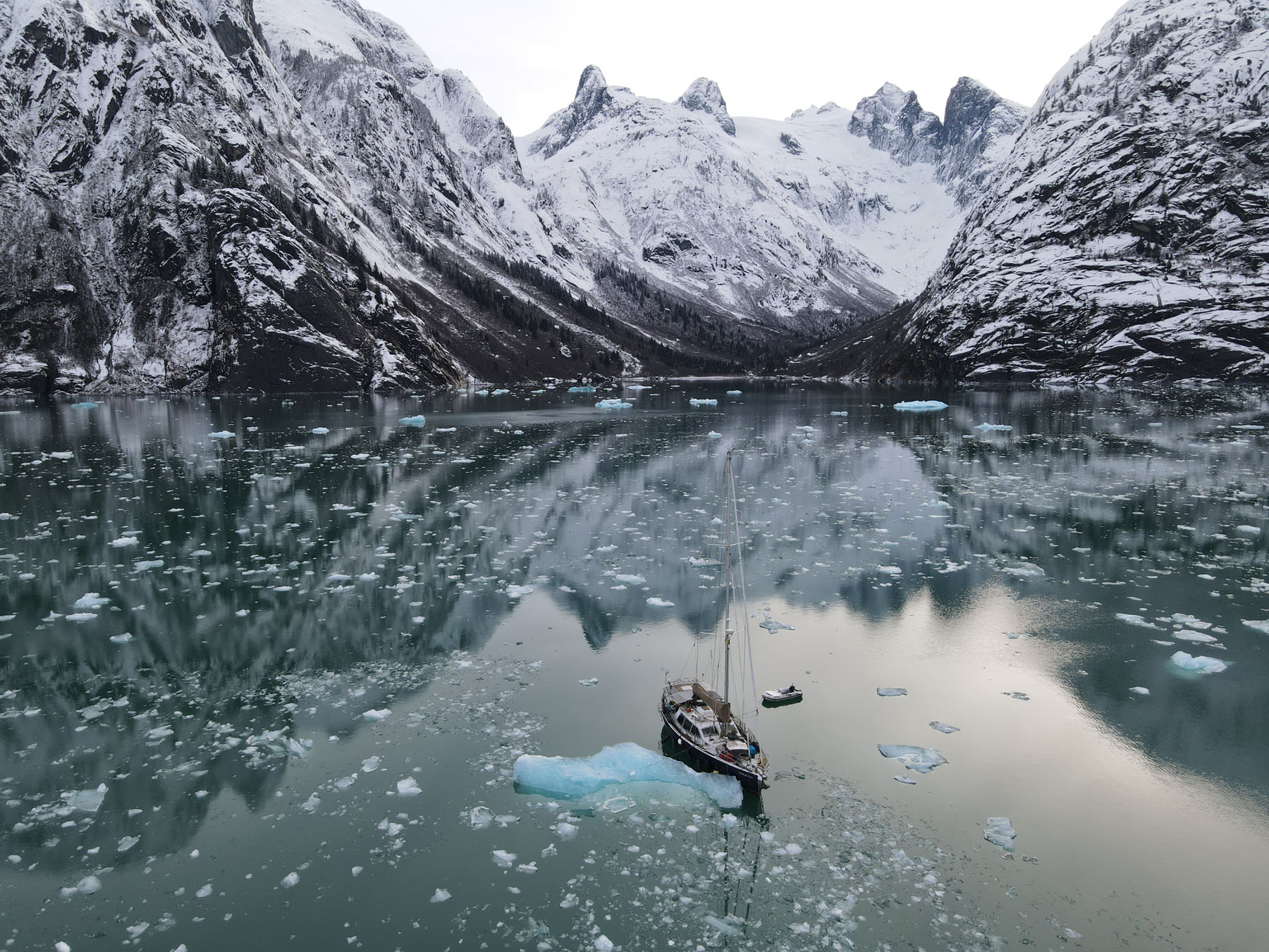

It can be hard to understand why some would choose to sail north until you see the raw beauty of the anchorages. Yes, it’s cold, but if you’re looking to get away from it all, this is the way to succeed. The anchorages are uncrowded, with not another cruising boat in sight!
Don’t Chafe on Me
Earlier this year we shared some of The Resourceful Sailor’s tips on chafe gear. In this second installment we bring you some more simple and very handy tricks to keep you safe from the chafe.
How do I protect my boat from the anchor gear and vice versa? As I committed to anchoring more on my Pacific Seacraft Flicka 20, Sampaguita, this became a pressing question. Due to weight considerations and my cruising grounds, I opted for 30 feet of chain, with 300 feet of nylon line, for my anchor rode. After some practice sessions, I pinpointed the chafe spots and aimed to eliminate them.
Sampaguita has a bowsprit with a bare teak platform, and this is where the anchor is stored. It sits on a bow roller, and the anchor is deployed and weighed through a slot in the platform. The chafe points on the platform are where the anchor rests in the stowed position, and where the anchor rode rubs when taken in.
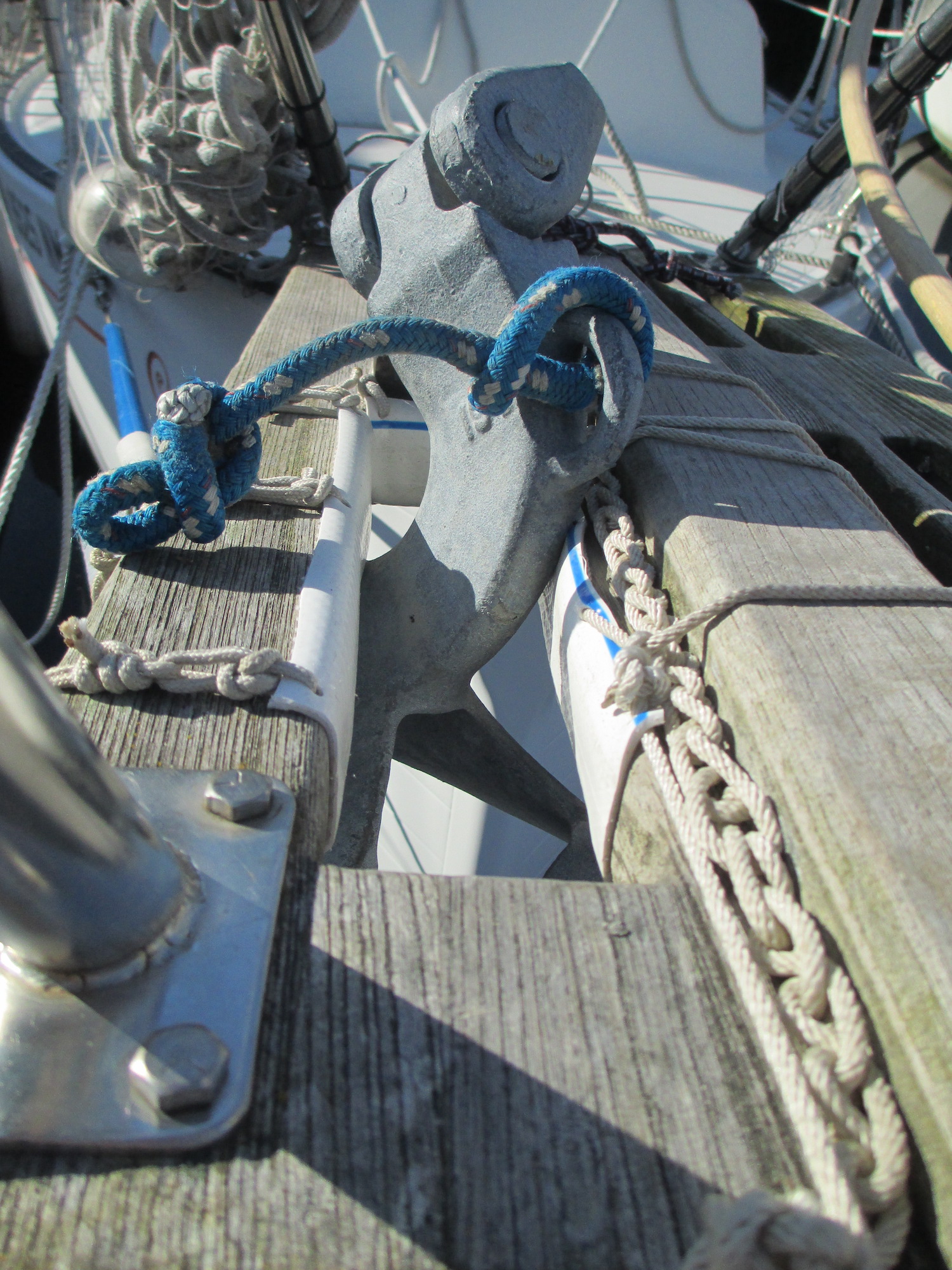
My first thought was to add stainless steel or aluminum chafe guards on the contact spots. Small pieces would be easy and inexpensive to come by, but there were a couple of issues that concerned me. First, I would have to use screws in the platform, making entry points for water, as well as being destructive. Also, water collecting and sitting under the metal pieces was a concern. Teak is rot-resistant, but not rot-proof. And the oils in the teak prevent sealants from retaining long-term adhesion.
So I went with a low-tech approach. I had some old vinyl water hose that I cut to fit. Using a leather punch, I added holes to these to allow them to “breathe” and the wood underneath to dry. I used nylon cord to tie these in place. This would be non-destructive, so if it didn’t serve its purpose, there was no harm done.
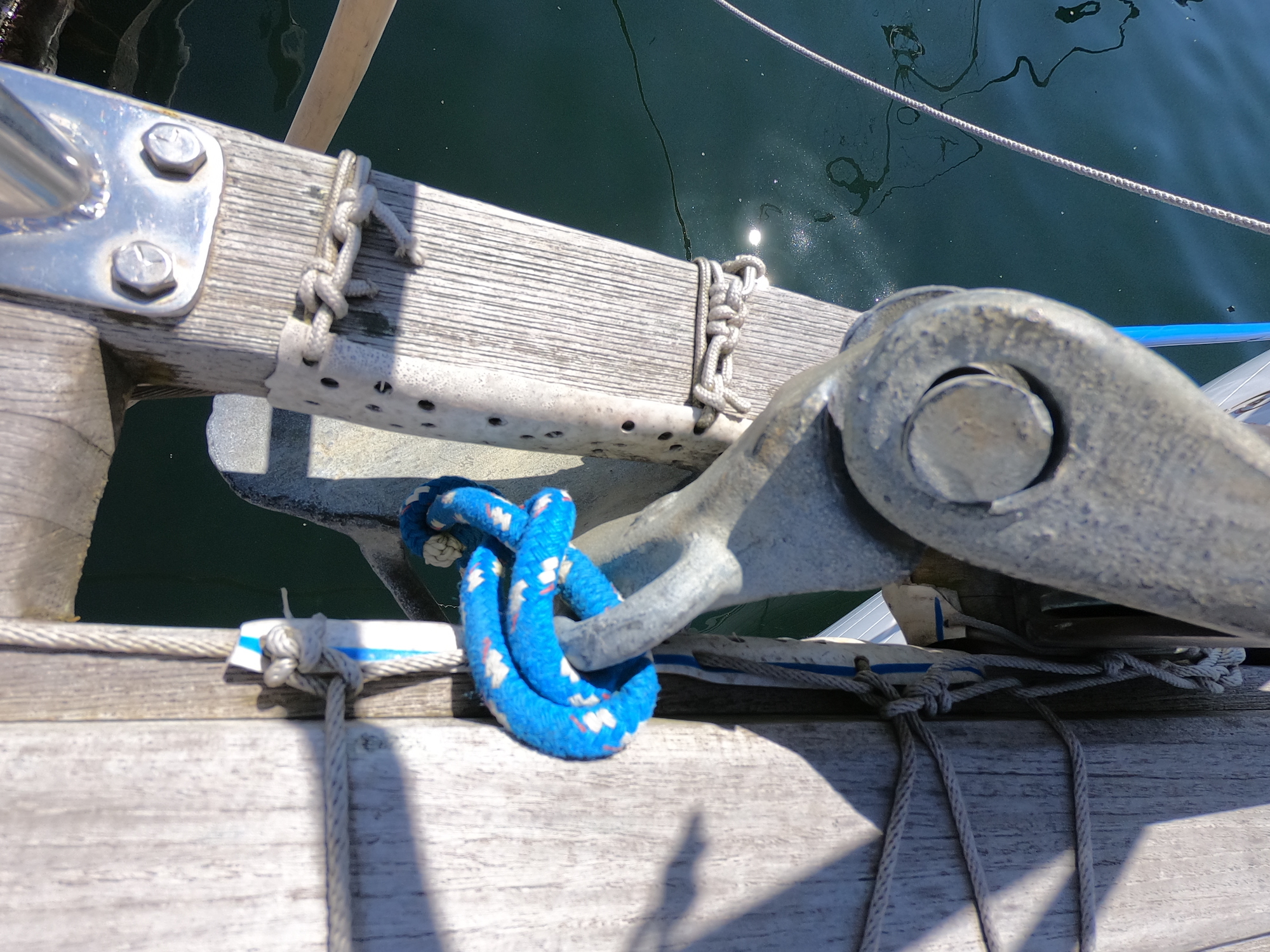
While swinging on the hook, the bobstay and the bowsprit shrouds are the problem spots. In the Pacific Northwest, we often have currents to contend with in addition to the wind. When these are in opposition, the boat will often sit in awkward, sometimes side-to positions. Plus, with nylon rode and a Flicka’s windage at the bow, Sampaguita wants to “sail” back and forth at anchor. In either case, the nylon rode rubbed on the standing rigging.
I went to the local hardware store, and for $5.47, I purchased several feet of rigid blue nylon tubing. I cut this to lengths for the bobstay and bowsprit shrouds, then spiral-cut them lengthways and slipped them on. They fit loosely enough to air-dry, and looked good too, matching my blue canvas. I then added a piece of vinyl hose to the upper turnbuckle of the bobstay, stitching it on with waxed twine to cover the sharp edges.
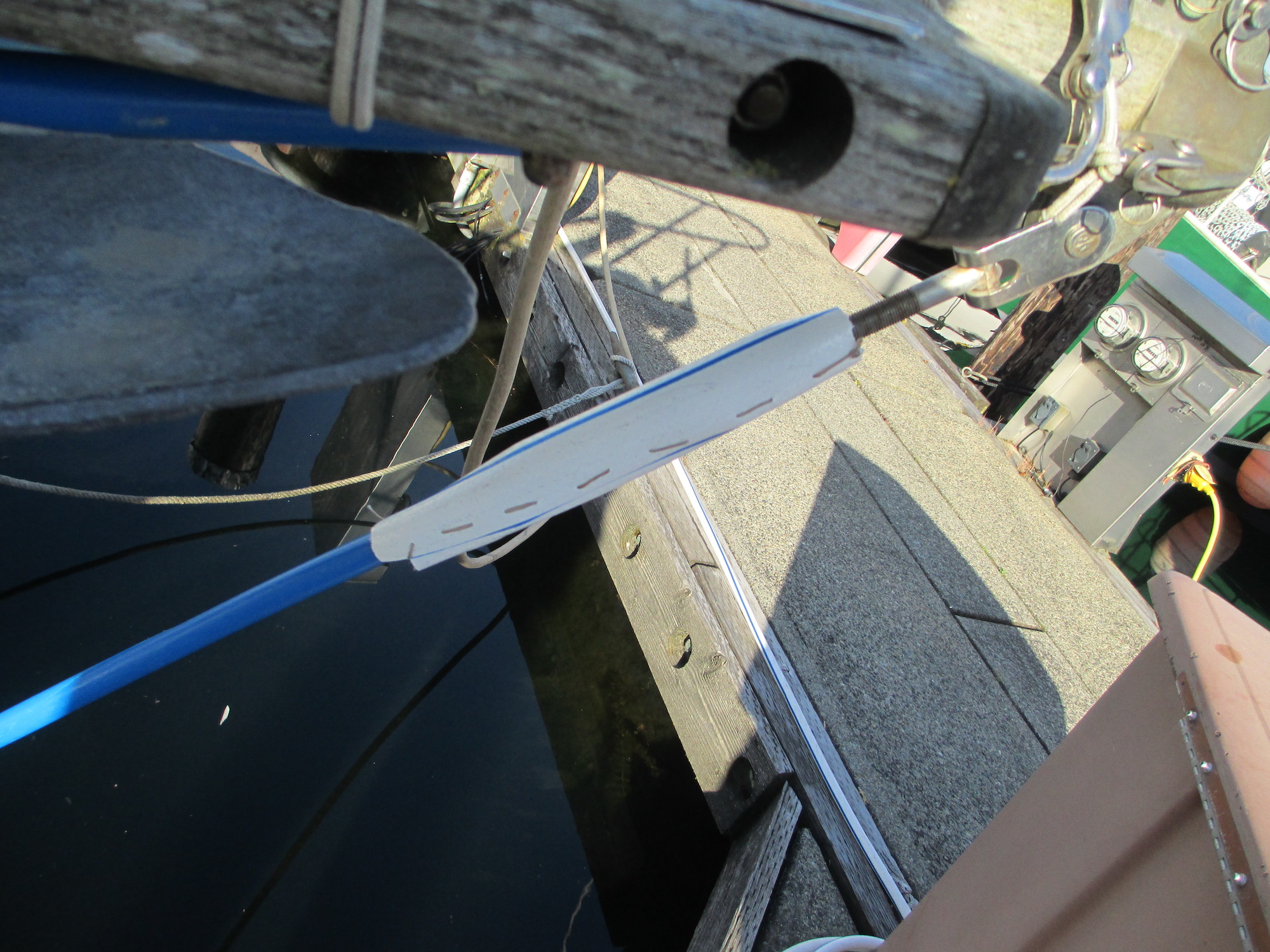
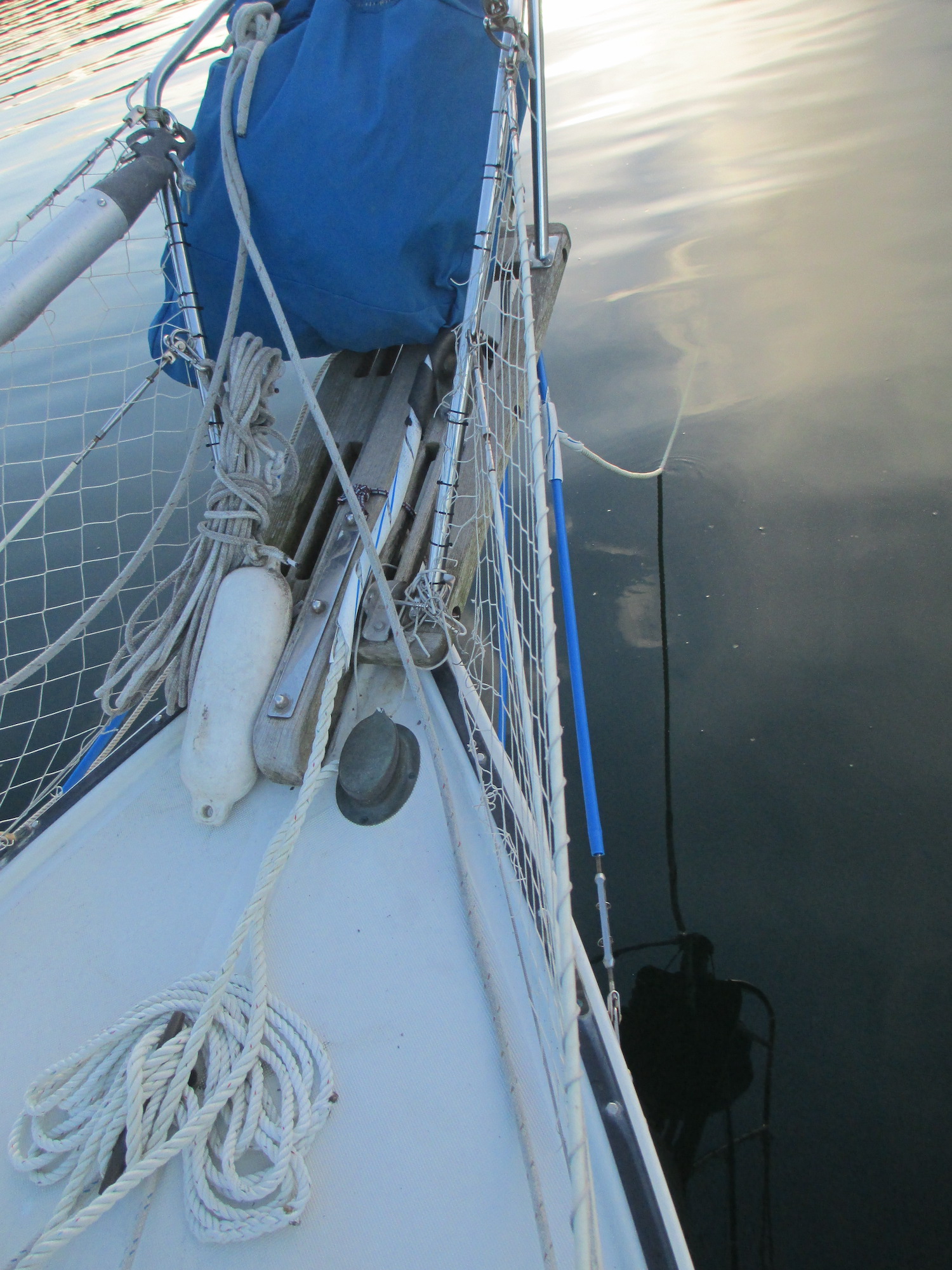
While the above are permanent installations, there is a final addition to the setup that I add after I set the anchor, and remove when I weigh it. I have a four-foot length of spiral-cut water hose that I add to the rode. It extends from the hawser, through the platform, and beyond the bobstay. Then, a shorter length of automotive hose that I put over that for extra protection against the bow roller and the bobstay, in case conditions cause a lot of tension on the rode.
I added these chafe guards in spring 2016. They are still intact, serving their purpose after somewhere around one hundred evenings at anchor in a large variety of conditions, some of them quite extreme. I haven’t experienced any chafe in these areas, and a bonus is reduced anchor-rode noise in the cabin. The one guard I have had to readjust on occasion is that just below the anchor roller, in place to protect the platform as the many feet of anchor rode are pulled up. It wants to shift when the friction is high. Adding the final hoses after a long day is tedious, but peace of mind is the reward.
When you need to come up with economical solutions, The Resourceful Sailor hopes to stimulate the brain on how to make this happen. Remember, make your solutions safe and prudent, and have a blast.
KKMI Wishes you Happy Haul-idays

As an essential business, we want you to know that we are here to (safely) help you keep your boat ready to shelter in place on the Bay and beyond. Wishing you a safe, sane and happy Holiday Season!
Coville Pulls the Plug on Jules Verne Attempt
Sodebo Ultim 3 Ends Record Attempt
On Friday, after a little more than 16 days at sea, skipper Thomas Coville and crew decided to end their try for the Trophée Jules Verne on Sodebo Ultim 3.
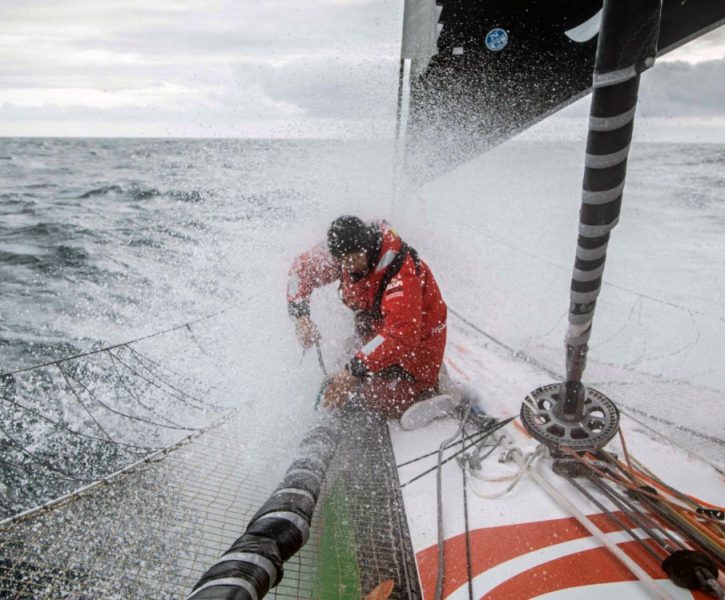
After trying to repair the starboard rudder, Coville chose not to “tempt the devil.” While sailing at more than 30 knots between the Kerguelen Islands and Cape Leeuwin, the crew noticed damage to the rudder. They then worked on the problem for several hours before deciding to head to Réunion Island, 2,300 miles to the northwest. There, they plan to effect repairs to improve the 105-ft trimaran’s reliability before sailing home to Lorient, France.
The Jules Verne Trophy recognizes the fastest nonstop circumnavigation of the globe via the Great Capes. Francis Joyon and crew on IDEC Sport are the current record holders.
Vendée Globe Reaches Australia
Meanwhile, the solo sailors in the Vendée Globe nonstop around-the-world race are making quick work of the Southern Ocean. Race leader Charlie Dalin lit the afterburners on his IMOCA 60 foiling monohull Apivia. He sustained averages of 24 knots. He crossed the longitude of Cape Leeuwin at 11:25 hours UTC Sunday. Thomas Ruyant on LinkedOut crossed Leeuwin 3 hours and 9 minutes later. Yannick Bestaven on Maître CoQ IV followed only nine minutes behind, and has since passed Ruyant to take over second place.
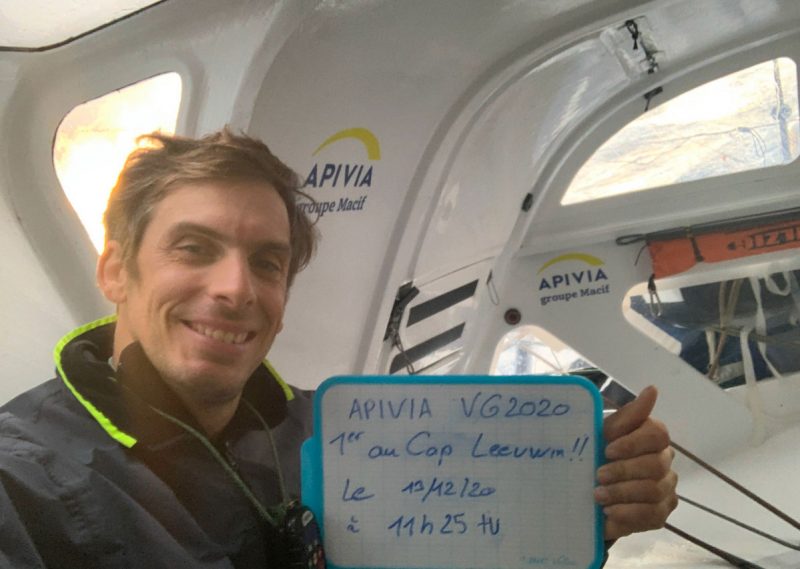
The jury is still out on how much redress to give Jean Le Cam for his rescue of Kevin Escoffier, whose boat, PRB, folded in half and sank south of the Cape of Good Hope. Le Cam was in fourth place at the time that he diverted to go to Escoffier’s aid. Escoffier had been sailing in third place at the time. Also awaiting the decision are Yannick Bestaven, who was sailing in sixth place at the time, and Boris Herrmann, eighth, who also diverted from their race. Yes We Cam! is now in fifth place and passing Cape Leeuwin, the southwest corner of Australia.
The latest dropout is Frenchman Fabrice Amedeo, 42, on Newrest – Art & Fenêtres. The failure of his backup computer on Thursday capped a number of problems. On Friday he wrote, “Since yesterday I have literally been blind. Due to a new computer problem, I can no longer download the weather files, calculate the optimal course, the fastest possible route and importantly the safest possible.” Twenty-seven boats out of the 32 starters remain on the race course.
Solo Solo Circumnavigation Carries On
Going on his own, alone both on his boat and on his course, is Californian Whitall Stokes, continuing his San Francisco-to-San Francisco attempt. Whitall and his Open 50 Sparrow are seeing nice conditions at latitude 39 south on their way to Cape Horn. “We are enjoying a champagne sailing day today,” he writes. “Cooler and drier weather, and seas much calmer than yesterday. Decks mostly dry, so that allows me to eat and read outside. Lovely going.”
Man Overboard in Berkeley Was Not a Drill
November 22, 2020, is a day etched into the minds of a handful of Bay Area sailors. Niklas Hache was singlehanding his 22-ft Santana outside Berkeley Marina when his boom swung and knocked him overboard. The current and the cold water quickly conspired to create a life-threatening situation for the 32-year-old sailor.
Fortunately Hache was wearing a PFD, which activated soon after he hit the water. However, the cold had already affected his thinking, and it took him a little time to remember the VHF strapped to his vest. Within minutes of Hache’s sending a mayday alert, four sailboat crews were on the lookout for a person in the water — a difficult task in any situation. Approximately 15 minutes later the US Coast Guard had dispatched a boat, followed by a helicopter.
Searching sailors spotted Hache’s boat adrift, but after 30 minutes there was still no sign of its skipper. Despite his arm-waving and shouting, Hache remained invisible to nearby boats. By this time he was feeling the effects of hypothermia and was, to his knowledge, a long way from being rescued.
Ultimately Hache’s rescuers appeared aboard the Emerald Sea, and according to the boat’s crew, their practice drills paid off and Hache was successfully hoisted aboard Emerald Sea (also known as Emmy).
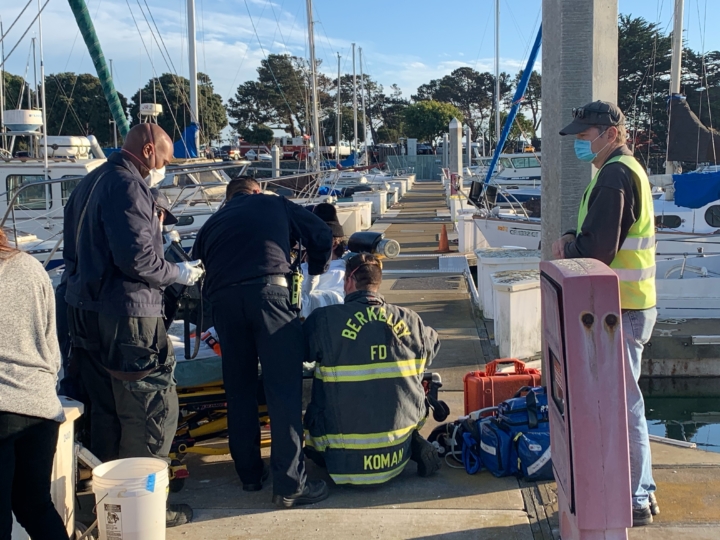
But these are only the facts. The real story lies in the thoughts and feelings of the overboard sailor, those who searched, and those involved in his rescue. Hache’s story had a happy ending, but it could have turned out otherwise.
We’ll bring you the full account of his rescue, in January’s Latitude 38 magazine.
Classy Classified Deadline for January Is Tomorrow!

To get your ad into the January issue, the deadline is TUESDAY, December 15, at 5:00 p.m.
